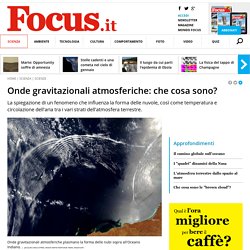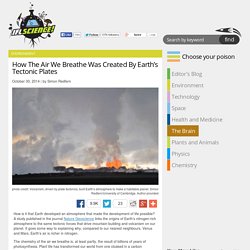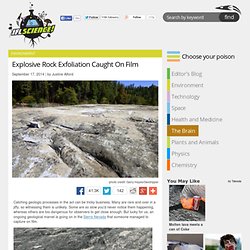

Plate Tectonics - Video and a Google Earth Lesson Plan. The Antarctic Food Web Game. Nautilus - Gli Esopianeti, un viaggio nello spazio extrasolare. Oggi conosciamo poco meno di 2000 pianeti - di tutte le masse e di tutte le dimensioni - fino a pianeti con dimensioni simili alla Terra, molti dei quali appartengono a sistemi planetari veri e propri.

Uno degli obiettivi della ricerca dei pianeti extrasolari – gli esopianeti - è l’identificazione di pianeti abitabili. Ma come si scoprono gli esopianeti, dal momento che non è così facile individuarli? Grazie a nuovi e sofisticati strumenti di rilevazione sappiamo che un esopianeta c’è anche se non lo si vede, perché lascia tracce intorno a sé: la maggior parte dei pianeti extrasolari, infatti, è stata scoperta grazie alla misura dell’effetto gravitazionale che il pianeta esercita sulla stella.
Commenta Tags Condividi questo articolo Inserisci il codice nel tuo articolo. Onde gravitazionali atmosferiche: che cosa sono? Le onde di gravità atmosferica sono oscillazioni dell'aria, con un periodo che va dai 10 minuti fino al giorno, che provocano le caratteristiche increspature nelle nubi talvolta visibili in foto o dal finestrino di un aereo.

Possono avere una lunghezza d'onda di migliaia di chilometri e sono provocate dal contrasto tra i movimenti verticali ascendenti e discendenti dell'aria in atmosfera. Come si formano. Tra le loro cause troviamo i moti convettivi che spingono i nembocumuli verso l'alto, la presenza di rilievi che fa sì che l'aria che vi si infrange contro si alzi e, per contro, la diminuzione della temperatura raggiunta dall'aria ad alta quota, che ne aumenta la densità e la fa ridiscendere nuovamente: questi movimenti si ripetono a ciclo continuo, causando nell'aria onde simili a quelle marine.
Perché si studiano. Incredible Video Shows Volcanic Eruption in Papua New Guinea. A video captured by an Australian couple shows the destructive power of a volcanic eruption.

Mount Tarvurvur located in Papua New Guinea erupted on August 29. The event sent plumes of debris and ash thousands of feet into the sky. The volcano continued to erupt for several days afterwards The Australian couple, Linda and Philip McNamara, were on a boat nearby when it erupted again. The video also captures the sonic boom that rippled through the atmosphere. Eruptions have occurred at Mount Tavurvur every few years. Read this next: Incredible Photos of Volcanic Eruption in Iceland. Spreading Continents Kick-Started Plate Tectonics Billions of Years Ago. First described in the 1960s, plate tectonics explains how volcanoes build mountains and shape oceans.

But have these large-scale motions always been this way? A new computer model suggests that plate tectonics was kick-started by gravity and the spreading of continents during the early days of Earth. The work was published in Nature this week. Today, plate tectonics and the resulting movements of the crust and upper mantle (or lithosphere) are primarily driven by the “negative buoyancy” of cold plates—the top is cooler and denser than what’s below—which causes one plate to slip under another in a process called subduction.
This happens at mid-oceanic ridges: Hot rocks with low density float and move away from erupting ridges until they cool down, get denser than the underlying hot mantle, and eventually sink below to become recycled. How The Air We Breathe Was Created By Earth’s Tectonic Plates. How is it that Earth developed an atmosphere that made the development of life possible?

A study published in the journal Nature Geoscience links the origins of Earth’s nitrogen-rich atmosphere to the same tectonic forces that drive mountain-building and volcanism on our planet. It goes some way to explaining why, compared to our nearest neighbours, Venus and Mars, Earth’s air is richer in nitrogen. The chemistry of the air we breathe is, at least partly, the result of billions of years of photosynthesis. Plant life has transformed our world from one cloaked in a carbon dioxide-rich atmosphere – as seen on Mars or Venus – to one with significant oxygen. About a fifth of the air is made up of oxygen, and almost all the rest is nitrogen. Geoscientists Sami Mikhail and Dimitri Sverjensky of the Carnegie Institution of Washington have calculated what nitrogen is expected to do when it is cycled through the rocks of the deep Earth by the churning cycle of plate tectonics.
Nitrogen bubbles up. Explosive Rock Exfoliation Caught On Film. Catching geologic processes in the act can be tricky business.

Many are rare and over in a jiffy, so witnessing them is unlikely. Some are so slow you’d never notice them happening, whereas others are too dangerous for observers to get close enough. But lucky for us, an ongoing geological marvel is going on in the Sierra Nevada that someone managed to capture on film. dotysan/Mika McKinnon/io9 The process is caused exfoliation, which is a form of mechanical weathering in which curved slabs of rock detach and slough off from the rock below, resulting in a so-called exfoliation dome such as Yosemite’s spectacular Half Dome.
While weathering may typically be slow, the ongoing exfoliation at Twain Harte Lake in the Sierra Nevada is really something else. [Via Geotripper, ars technica and io9] Read this next: Goldfish Tumor Removal Operation Went Swimmingly.